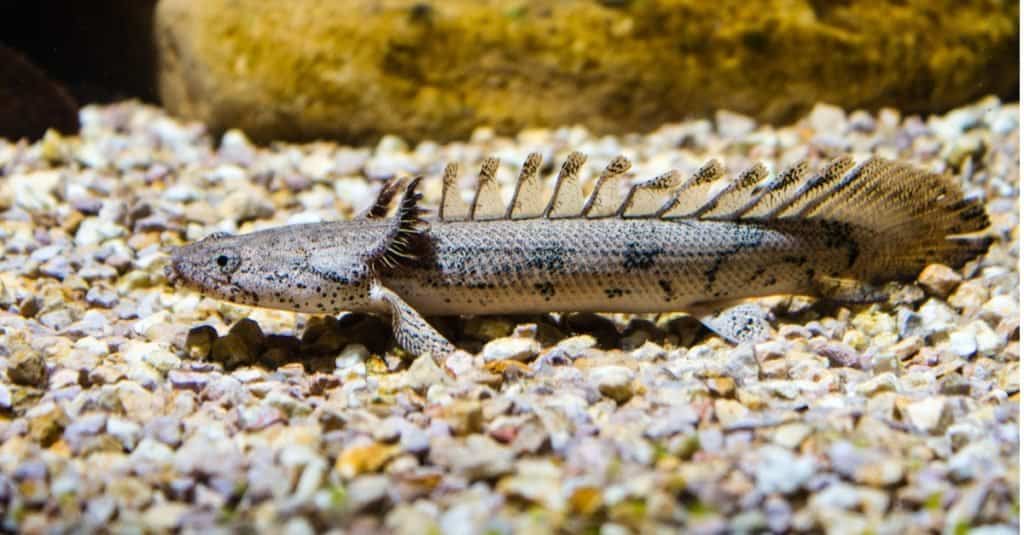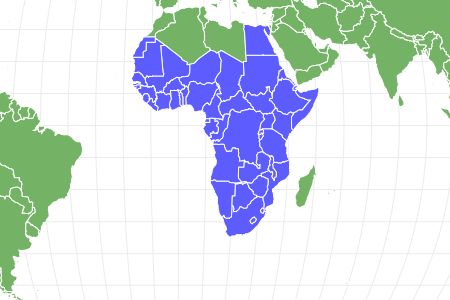Bichir
The bichir species is more than 400 million years old
Advertisement
Bichir Facts
- Prey
- Crustaceans, insects, vertebrates, and small fish
- Group Behavior
- School
- Fun Fact
- The bichir species is more than 400 million years old
- Estimated Population Size
- unavailable
- Biggest Threat
- Environmental damage
- Most Distinctive Feature
- Small, ray-like fins along an elongated back
- Other Name(s)
- Dragon fish, dinosaur eel
- Gestation Period
- 3-4 days
- Habitat
- Rivers and lakes
- Diet
- Carnivore
- Type
- Polypterid
- Common Name
- Bichir
- Number Of Species
- 13
View all of the Bichir images!
Bichirs are slender, prehistoric-looking fish that are often thought to resemble dinosaurs or eastern dragons.
Bichir fish are native to Africa and can be found in nearly every freshwater body on the continent. Their distinctive appearances and highly interactive personalities have also made bichirs incredibly popular as aquarium pets.
3 Incredible Bichir Facts!
- Taking a breath: Unlike other types of fish, bichir fish actually have lungs and are capable of breathing both in and out of the water. In fact, many will swim to the surface for a breath when the water is too muddy for their tastes.
- Nocturnal habits: These are predatory fish that come out at night. They like to eat bugs, worms, and other creatures that emerge from the mud when the sun goes down.
- Walking on land: The Senegal bichir fish is known for being able to use its fins to propel itself across the land for short distances. This lets the fish move between nearby ponds or catch prey that is trying to escape from the water.
Bichir Classification and Scientific Name
The scientific name for these fish is Polypterus, which means “many-winged.” This refers to the series of delicate fins that line the backs of all of them. The Polypteridae family belongs to the Actinopterygii class of ray-finned fishes. There is still a significant amount of debate as to how many different types exist and how they should be classified; at the moment, there are 13 recognized species.
Bichir Species
These fish are found in rivers and lakes across the entirety of Africa. There are currently 13 different species that are recognized by the scientific community, and many of these species have their own subspecies.
Some of the most popular types include:
- Ornate bichir: Polypterus ornatipinnis are known for their distinctive black and yellow patterns. Although they’re slightly aggressive towards other fish, their appearance makes ornate bichirs incredibly popular as aquarium pets.
- Senegal bichir: Also known as the dinosaur bichir, Polypterus senegalus is one of the most widespread types in Africa. They have large pectoral fins that they use to propel themselves across short stretches of land.
- Saddled bichir: Polypterus endlicheri endlicheri is a pale-colored bichir that occasionally appears with a striking striped pattern. Saddled bichirs are the largest subspecies and can get up to 30 inches long.
Bichir Appearance
These are long, slender fish that are often mistaken for eels. Instead of dorsal fins, these fish have a set of delicate ray fins that grow along their spines. They propel themselves with their pectoral fins, but they also have back fins and prominent tail fins. They come in a wide variety of colors and patterns that change based on their natural habitats. Dinosaur bichirs are a dark grey color, but ornate bichir come in striking shades of black and yellow.
These fish are often categorized by whether their upper or lower jaw protrudes. While it’s true that lower jaw bichirs often have a strong underbite, upper jaw bichirs typically have smooth jawlines that make the protrusion difficult to notice. Lower jaw bichirs are almost always larger than upper jaw bichirs.
Most of them grow to be 11-20 inches long, and they can weigh anywhere from 5-10 pounds. Saddled bichir are one of the longest subspecies; the largest recorded fish was 30 inches long.

©chonlasub woravichan/Shutterstock.com
Bichir Distribution, Population, and Habitat
These fish are native to Africa and can be found in nearly every shallow freshwater river and pond on the continent. Each body of water usually only contains one species of bichir; even in aquariums, they tend to attack other bichirs of different species. Dinosaur bichirs can be found all over, but ornate bichirs are limited to the eastern parts of the continent. These fish are incredibly common and are listed as either not extinct or of least concern.
Although they can live in any body of fresh water, the fish prefer muddy and silty environments. These fish are nocturnal, which means they spend most of their days sleeping at the bottom of the river. At night, they hunt for bugs, vertebrates, and other small creatures that inhabit the muddy shallows.
Bichir Predators and Prey
These fish are predatory creatures that will eat any animal smaller than them. Their natural prey includes shellfish, vertebrates, bugs, worms, and other fish that are small enough to fit into a bichir’s mouth.
When they are not hunting, they are relatively peaceful fish. They may show aggressive behavior if other predatory fish enter their territory, but they will generally leave large fish alone. These fish do not have natural predators, but they may still occasionally be caught and eaten by larger carnivores.
Bichir Reproduction and Lifespan
These are egg-laying fish that tend to breed once a year unless breeding is induced. They typically go through 1-2 day courting rituals in which the male chooses and attempts to woo a female. Once the couple has paired off, the female will release up to 300 eggs over a week-long period. The male fertilizes the eggs as they are released and then allows them to be scattered along the riverbed or across the aquarium floor.
The eggs only take 3-4 days to hatch. The fry is only 2-3 millimeters long, but they grow incredibly quickly. Most of them gain 2-3 centimeters of mass a day for the first few years of their lives. These fish in aquariums tend to live to be 15-20 years old; in the wild, their average lifespan is closer to 10 years.
Bichir in Fishing and Cooking
These fish is seen as an aquarium pet and are not traditionally used for cooking. Most of them sold in pet stores are bred and raised in a tank. Wild bichirs are not fished out of their habitats in quantities large enough to be recorded.
View all 284 animals that start with BBichir FAQs (Frequently Asked Questions)
Where are bichir found?
Bichir is native to Africa. The many different types of bichir can be found in freshwater rivers and streams across the entire continent.
How do you pronounce bichir?
Because the bichir is not native to either Europe or the Americas, the pronunciation of its name is often confused. The proper pronunciation of bichir is “bee-sheer.” Many westerners also use the incorrect pronunciation of “bee-keer.”
How fast does bichir grow?
Young bichir grows about 2-3 centimeters a month until they have reached their full length. Fish size is generally determined by the room in their tank and the amount of food that is available during their developmental stages. Bichir can keep growing for several years in the right conditions.
How big do bichirs get?
Most bichirs grow to be about 10 – 20 inches long. The largest is the saddled bichir, which can reach a fish size of about 30 inches.
Are bichirs aggressive?
Bichirs are predatory fish that are known to be mildly aggressive towards smaller fish. When you’re choosing tank mates for your bichir, stick with larger fish size, and avoid adding another bichir of the same species. Ornate bichir tends to be the most aggressive, but they are also considered to be the most attractive and are extremely popular in aquariums.
What size tank does a bichir need?
Bichir is large and active fish that need a big tank to thrive. The recommended minimum tank size for a bichir is 90 gallons.
What class do Bichirs belong to?
Bichirs belong to the class Actinopterygii.
What family do Bichirs belong to?
Bichirs belong to the family Polypteridae.
What order to Bichirs belong to?
Bichirs belong to order Polypteriformes.
What type of covering do Bichirs have?
Bichirs are covered in Scales.
In what type of habitat do Bichirs live?
Bichirs live in rivers and lakes.
What is the lifespan of a Bichir?
Bichirs live for 15-20 years.
How many species of Bichir are there?
There are 13 species of Bichir.
What is a distinguishing feature of the Bichir?
Bichirs have small, ray-like fins along an elongated back.
What is another name for the Bichir?
The Bichir is also called the dragon fish or dinosaur eel.
How many Bichirs are left in the world?
The population size of Birchirs is unknown.
What is an interesting fact about the Bichir?
The Bichir species is more than 400 million years old.
How do Bichirs have babies?
Bichirs lay eggs.
Thank you for reading! Have some feedback for us? Contact the AZ Animals editorial team.
Sources
- Wikipedia / Accessed December 28, 2020
- Live Aquaria / Accessed December 28, 2020
- Fishkeeping World / Accessed December 28, 2020
- Britannica / Accessed December 28, 2020
- Aquatic Community / Accessed December 28, 2020
- Fishbase / Accessed December 28, 2020
- Britannica / Accessed December 28, 2020
- Animal Scene / Accessed December 28, 2020


















